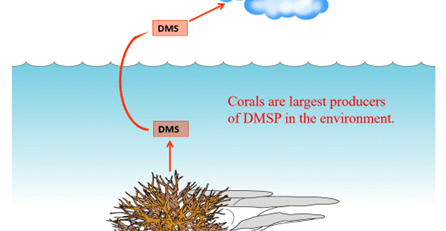Cladocopium thermophilum: A powerhouse of thermal tolerance
By Anna Fiesinger
Coral reefs face an existential threat from rising ocean temperatures, but one tiny alga is rewriting the rules of survival. Cladocopium thermophilum, a symbiotic alga found in the Persian Arabian Gulf’s extreme environment, has emerged as a critical player in the Gulf’s coral resilience. This microbe’s extraordinary ability to thrive in the world’s hottest seas offers hope—and lessons—for reefs globally.
Their high thermal tolerance and ability to withstand climatic changes has been linked to several factors, including their association with thermally resilient algae of the family Symbiodiniaceae1. Oftentimes, the symbiotic algae are referred to as the powerhouse of the coral organism, as they provide the coral with the necessary nutrients from their ability to photosynthesize. Of these, many studies have looked at and identified alga of the genus Durusdinium to be the most heat tolerant alga in coral. However, a symbiont species from the Persian Arabian Gulf challenges that notion: Cladocopium thermophilum.
Cladocopium thermophilum was first identified in the Persian Arabian Gulf2, where corals endure summer temperatures up to 35 °C and drastic seasonal swings. Genetic analyses revealed it as a distinct species, with unique markers in its chloroplast DNA that set it apart from other algae in the Cladocopium genus3,4. C. thermophilum variants, as identified through the analytical framework SymPortal5 that uses the ITS2 marker gene, are rare outside of the Persian Arabian Gulf, which suggests local adaptation over the course of its progression. Unlike typical coral symbionts, which bleach at just 1 °C above average summer high ocean temperatures, this alga dominates reefs year-round, even as temperatures fluctuate by ~20 °C seasonally.
More often than not, the partnership with coral-associated algae is stable over time. The host fidelity that C. thermophilum exhibits in corals in the Persian Arabian Gulf persists over seasons and even through heat stress episodes and bleaching events6. A study conducted as part of my doctoral thesis and likely to be released this year showed that C. thermophilum dominates populations even a decade apart. However, it was also discovered that the assemblage of these symbionts changed: We found different prominent C. thermophilum genotypes and the loss of certain genotypes altogether. What we do not know is whether the observed disappearance of certain genotypes in lieu of the appearance of other genotypes is a sign of an adaptive response to overcome the extreme thermal challenges that arise in the Persian Arabian Gulf, or whether it signals the beginning of the end.

Al Saada Reef in the Persian/Arabian Gulf, off the coast of the United Arab Emirates, is dominated by one coral species—Porites harrisoni—a prominent host for the symbiotic alga Cladocopium thermophilum.
Important questions that we still must ask when looking at this alga is what exactly is the driving force in C. thermophilum’s exceptional heat tolerance? Is it genomic? Could C. thermophilum survive if introduced in other, more temperate reefs? Could it form stable symbiosis with corals elsewhere and if so, would it aid their adaptive responses to climate change?
Cladocopium thermophilum reminds us that evolution has already crafted solutions to extreme climates. By studying its secrets—from gene variants to bacterial teamwork—scientists aim to buy time for reefs in a warming world. However, this alga’s success also underscores the urgency of climate action: even nature’s toughest survivors have limits, and we do not know if it can keep up with the accelerated pace of global climate change as we experience it today. It reminds us to take action, urgently!
References:
1LaJeunesse et al. 2018: https://www.cell.com/current-biology/fulltext/S0960-9822(18)30907-2
2Hume et al. 2015: https://www.nature.com/articles/srep08562
3Hume et al. 2016: https://www.pnas.org/doi/abs/10.1073/pnas.1601910113
4Hume et al. 2018: https://www.frontiersin.org/journals/marine-science/articles/10.3389/fmars.2018.00138/full
5Hume et al. 2019: https://onlinelibrary.wiley.com/doi/full/10.1111/1755-0998.13004
6Howells et al. 2020: https://onlinelibrary.wiley.com/doi/full/10.1111/mec.15372










